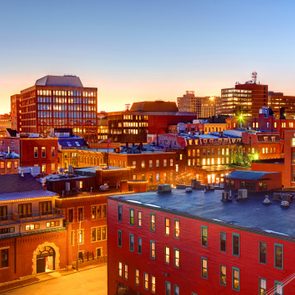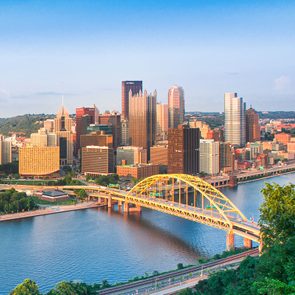The happiest city in the U.S. is famous for its hustle and bustle

New Survey: This Big City Ranks No. 1 in the U.S. Happiness Index—You’ll Never Guess Where It Is

The concept of happiness—what it entails and how we achieve it—is highly subjective, and it’s commonly understood that what makes one person happy might not make another person happy. Factors such as religion, traditions, politics and personal history are major contributing factors. But we can all agree that where you live can make a big difference.
“There are billions of factors that distinguish us and create our individual stories,” states the website for the Institute for Quality of Life, the think tank behind the Happy City Index. The Institute believes that, regardless of other circumstances, there are two major foundations for creating a happy place: building relationships, which stem from the innate need to belong and contribute to our happiness, and education, which can’t be overemphasized.
Keep reading to learn more about the sixth edition of the Happy City Index and the key aspects that help a place earn a spot on the list.
Get Reader’s Digest’s Read Up newsletter for more wellness, travel, humor, tech, cleaning and fun facts all week long.
What’s the methodology of the Happy City Index?
The Happy City Index team consists of more than 200 individuals worldwide who gathered, processed and analyzed data in order to produce this list of the happiest cities around the globe. Cities were only included if reliable, measurable and comparable data was available, which is why your favorite places might not be on this list even if they’re in one of the best states in the country.
The research is extensive, but the Happy City Index team acknowledges that “a sense of security, family relationships and the fulfillment of dreams is only a small part of a much larger picture” and that labeling one city “the absolute best” is unfair and unrealistic. Instead, the Happy City Index celebrates trends that boost happiness.
Each year, the index identifies cities that stand out as some of the happiest places on the planet, and these make its list of Gold Cities. The research team identified 82 indicators—up from 76 last year—under six main themes: citizens, governance, environment, economy, health and mobility.
The Happy City Index’s full report goes into great detail, but here’s a snapshot of the six main themes.
Citizens
According to the Institute for Quality of Life, a city that prioritizes happiness focuses on its people and their needs. In the area of Citizens, the research focuses on how well cities serve their people.
A top concern for the Happy City Index is a city’s education system—from nursery school to advanced degrees, along with lifelong learning—plus other important categories such as inclusivity for vulnerable groups, innovation support, housing affordability, cultural access and digital literacy.
Governance
Happy cities include residents in the decision-making processes, and this transparency helps citizens feel heard and understood. People are more likely to feel happy in their city when they’re aware of strategic planning that leads to their overall quality of life.
Environment
It’s well known that cities with ample parks, trails and open space have happier residents. When people can get outside for relaxation—or even use trails and bike lanes to navigate the city—everyone is better off, both the individuals themselves and the environment.
The Happy City Index also considered how cities manage natural resources, as well as their approaches to addressing water and electricity usage, pollution, waste, wastewater management and recycling.
Economy
In this theme, the Happy City Index assessed economic vitality through various categories, including Gross Domestic Product (GDP), which represents the total value of goods and services produced over a specific period, as well as the level of business innovation and entrepreneurship in the city.
Because not everyone can—or wants to—own a business, they also considered labor market health, which includes factors such as employment of people with disabilities, unemployment rates, parental leave and the ratio of wages to the cost of living.
Health
Newly added in 2025, this theme revolves around safety, which encompasses everything from criminal activity and traffic incidents to vaccination education and accessibility.
The research team examined financial liabilities for a city—such as the cost burden of car accidents on a community—and how those funds could be better allocated. The health theme also addresses mental health support, general health-care accessibility and affordability, food security, chronic disease rates (including obesity and diabetes), life expectancy, work-life balance and overall public safety programs.
Mobility
There is some crossover between environment (public transportation) and health (traffic accidents), but the theme of mobility is largely about traffic management and efficient, easy-to-use public transportation. To achieve a high score in this category, cities must utilize technologies that provide real-time data, enabling individuals to choose the fastest mode of transportation, avoid traffic jams and select the most efficient routes. Time saved getting from one place to another allows residents time to engage in hobbies, enjoy time in nature or spend time with friends and family.
Which U.S. city ranked highest on the Happy City Index?

Though some might picture it as one giant concrete block, with residents who don’t take the time to get to know one another, New York City scored 902, earning the Happy City Index’s highest ranking in the U.S. and #17 worldwide. Read on to learn how NYC earned its Gold City status.
Why did New York City rank highest?
The Happy City Index refers to NYC as “a global icon of finance, culture and innovation.” Here’s a look at the areas where The Big Apple excels and what makes it rank so high. If you’ve ever felt the power and energy of New York City—home to more than 9 million people—you get it.
Education and innovation
Education is prioritized in New York City, with 6.7% of the population holding a master’s degree and 20% speaking at least two languages. The city is home to a significant number of top-ranking universities, and 76% of residents are proficient in digital literacy. In terms of innovation, there are 10.02 patents per 10,000 residents, and the Happy City Index describes New York City as “an intellectual and technological powerhouse.”
Governance and transparency
New York has notable civic engagement, with 0.33 per 1,000 residents involved. The city boasts extensive open data platforms, with 4,000 datasets available to the public, and digital governance is well-integrated. In addition, the city offers e-services that allow electronic payments, online appointment scheduling and more, all of which help residents save time.
Health and well-being
In the health and well-being category, NYC residents are about average for several metrics. New Yorkers have 3.6 doctors per 1,000 residents, 92% have medical insurance, life expectancy is 77.7 years and the average number of weekly working hours is 36.4. However, the city has some challenges when it comes to crime, and the obesity rate is 41.9%, slightly above the national average.
Mobility and transport
Because of NYC’s extensive public transportation system, many people can live in the city without needing a car. The city offers significant green transportation options, such as bike and scooter share programs, along with an intelligent traffic management system that keeps people moving. The Big Apple is tech-savvy, with real-time public transport data and convenient apps for everything from trip planning to paying with a single tap on your smartphone.
A downside in this category is that only 30% of public transport options are fully adapted for people with mobility disabilities.
Environment and sustainability
Considering New York’s huge population, the city does a remarkable job keeping the streets clean and prioritizing sustainability. The recycling rate is slightly above the national average at 35%, and air pollution levels are relatively low, proving that sustainability initiatives are working. As of April 1, 2025, NYC requires residents to compost and separate food scraps, food-soiled paper and yard waste from general garbage. New York City promotes renewable energy options and has implemented a biodiversity protection strategy.
Economy and business
New York is a global economic driver, and the city welcomes innovation and fresh ideas. There are 228.09 businesses per 1,000 residents, significantly higher than most of The Happy Index’s top 30 Gold Cities. When it comes to economy and business, New York City—home to the New York Stock Exchange and Wall Street—is in a league of its own.
What other U.S. cities ranked highly?
There may be a lot of happy cities in the U.S., but Minneapolis is the only other city to rank in The Happy Index’s top 30 as a Gold City. Minneapolis came in at #30, with a score of 845. Below are other U.S. cities that made it on the Happy City Index list of 200 cities around the world.
- San Diego: #34 with a score of 831
- Washington, DC: #43 with a score of 813
- Salt Lake City: #56 with a score of 780
- Columbus, Ohio: #63 with a score of 771
- Los Angeles: #70 with a score of 759
- Seattle: #80 with a score of 750
- Baltimore: #84 with a score of 741
- San Antonio: #89 with a score of 726
- Nashville: #96 with a score of 718
- Indianapolis: #112 with a score of 699
- San Jose, California: #119 with a score of 689
- Boston: #131 with a score of 672
- Portland, Oregon: #141 with a score of 647
- Orlando: #176 with a score of 582
- Phoenix: #181 with a score of 574
- Houston: #198 with a score of 552
RELATED:
- New Report: This Is the Happiest State for Retirees
- These Are the Most and Least Stressed States in America—Which May Explain a Lot About How You’re Feeling Right Now!
- New Report: This Is the Most Welcoming City in the U.S.
Why trust us
At Reader’s Digest, we’re committed to producing high-quality content by writers with expertise and experience in their field in consultation with relevant, qualified experts. We rely on reputable primary sources, including government and professional organizations and academic institutions as well as our writers’ personal experiences where appropriate. We verify all facts and data, back them with credible sourcing and revisit them over time to ensure they remain accurate and up to date. Read more about our team, our contributors and our editorial policies.
Sources:
- Institute for Quality of Life: “#2025 Happy City Index”
- U.S. Census Bureau: “Health Insurance Coverage in the United States: 2023”
- Centers for Disease Control and Prevention: “Obesity and Severe Obesity Prevalence in Adults”
- New York City Department of Sanitation: “Curbside Composting”



